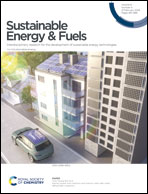Retracted Article: Methane conversion for hydrogen production: technologies for a sustainable future
Abstract
Industrial and technological developments have resulted in a rapid increase in the rate of global energy consumption with the energy demand expected to increase by 33% by 2035. Fossil fuel resources are the dominant source of energy and due to the increased use of fossil fuels, the amount of carbon emissions have grown the highest in the past several years. This also led to an increase in the emission of greenhouse gases (GHGs) like CO2, NOx, and SOx, which contribute to climate change. Moreover, with the world's fossil reserves getting depleted, it is necessary to move towards a sustainable and environmentally genial source of energy. Various technologies are available for the production of hydrogen, among them catalytic decomposition of methane (CDM) to produce hydrogen as a COx free technology have gained the highest importance in recent years due to the CO free production of hydrogen. In this study we will analyze and discuss different carbon nano materials (CNMs) to be recycled as valuable byproduct for different purposes. Moreover, the financial and ecological assessment of CDM will be compared with methane steam reforming in terms of CO2 emission, coal gasification, productivity, and cost of hydrogen production. Catalytic decomposition of methane may be a reliable and convenient technology for on-site maximum production of hydrogen on a small or moderate industrial scale. Ni-based, Fe-based, carbonaceous catalyst and noble metals for the CDM process will be addressed. Prioritizing hydrogen/carbon yield and production costs, iron based catalysts are ideal for catalytic decomposition of methane. Though catalysts based on nickel exhibit a much higher hydrogen production with 0.39 mol H2 per g cat. per h compared to Fe-based ones with 0.22 mol H2 g cat. per h, hydrogen cost of the former is assumed to be 100-fold higher ($0.89/$0.009). Furthermore, CDM performances on various types of reactors will be addressed, the molten-metal catalyst/reactor may be a suitable path for the commercialization of CDM. Lastly, the synthesis mechanism, characterization, and application of carbon byproducts with diverse structures and morphologies will be described in this article. Unlike other studies, the current review will show that economical Fe-based catalysts (10 tons H2/1 ton iron ore) and novel molten-metal reactors (with 95% methane conversion) for CDM are the more suitable research directions for the basic understanding of CDM and moreover carbon nanomaterials synthesized by CDM could be also exploited for supercapacitors, as oil for lubrication and for wastewater purification.



 Please wait while we load your content...
Please wait while we load your content...